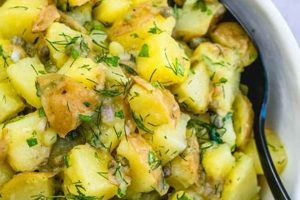Exceptional potato salad involves a harmonious blend of properly cooked potatoes, flavorful dressings, and complementary ingredients. A classic example combines tender potatoes, mayonnaise, mustard, celery, onion, and seasonings. Variations can include different potato types, additions like hard-boiled eggs or pickles, and a range of dressings from vinaigrette-based to creamy and tangy.
A well-executed potato salad serves as a versatile side dish, suitable for picnics, barbecues, potlucks, and holiday gatherings. Its adaptable nature allows for customization to individual preferences, accommodating dietary restrictions and diverse palates. Historically, potato salad has evolved from simple potato and vinegar combinations to the more complex and flavorful versions enjoyed today, reflecting culinary traditions and regional influences.
This article will explore the nuances of creating outstanding potato salads, covering key aspects such as potato selection, cooking methods, dressing variations, and ingredient pairings. It will also offer insights into achieving the perfect balance of textures and flavors, ensuring a delightful culinary experience.
Tips for Exceptional Potato Salad
Achieving potato salad excellence relies on attention to detail throughout the preparation process. These tips offer guidance on creating a dish that stands out in flavor, texture, and overall appeal.
Tip 1: Potato Selection Matters: Opt for waxy potatoes, such as Yukon Gold or red-skinned varieties. These hold their shape well during cooking and provide a creamy texture.
Tip 2: Uniform Cooking is Key: Ensure potatoes are cooked evenly to avoid a mix of mushy and firm pieces. Dice potatoes into uniform sizes before boiling or steaming.
Tip 3: Seasoning from the Start: Season the cooking water generously with salt to infuse the potatoes with flavor from the inside out.
Tip 4: Gentle Handling Prevents Mush: Avoid overmixing or aggressively stirring the cooked potatoes, as this can lead to a mushy consistency. Gentle folding is recommended.
Tip 5: Dressing Timing is Crucial: Dress the potatoes while they are still slightly warm to allow for better absorption of flavors. However, avoid adding dressing to piping hot potatoes, as this can cause the mayonnaise to break down.
Tip 6: Flavor Balancing Act: Balance the richness of the dressing with the acidity of vinegar or lemon juice. A touch of sweetness can also enhance the overall flavor profile.
Tip 7: Ingredient Harmony: Consider the complementary flavors of added ingredients. Classic additions like celery, onion, and hard-boiled eggs offer textural and flavor contrasts. Experimenting with other ingredients such as pickles, olives, or fresh herbs can add unique dimensions.
By following these guidelines, one can elevate potato salad from a simple side dish to a culinary highlight. Careful attention to potato selection, cooking techniques, and flavor balancing ensures a truly exceptional result.
The following section will delve into specific recipe variations, providing concrete examples of how to implement these tips and create memorable potato salads.
1. High-quality Potatoes
High-quality potatoes form the foundation of exceptional potato salad. The potato’s variety significantly influences the final dish’s texture and flavor. Waxy potatoes, such as Yukon Gold or red-skinned varieties, possess a dense, creamy consistency that holds its shape well after cooking, preventing a mushy salad. Their inherent sweetness complements a range of dressings and seasonings. Conversely, starchy potatoes like russets, while excellent for baking or frying, tend to crumble when boiled, resulting in a less desirable texture for potato salad. Choosing the correct potato variety is the first crucial step towards a successful outcome. For instance, a salad featuring waxy potatoes dressed in a vibrant vinaigrette maintains distinct potato pieces, showcasing their texture and individual flavor, while a similar salad made with starchy potatoes might become gluey and unappetizing.
Beyond variety, the potato’s condition also plays a vital role. Firm, unblemished potatoes with minimal sprouting indicate freshness and optimal quality. These potatoes contribute a clean, earthy flavor that enhances the overall taste profile of the salad. Conversely, potatoes with soft spots, green skin, or excessive sprouting can impart off-flavors and negatively impact the final product. Careful selection at the grocery store ensures the best starting point for a delicious potato salad. One might encounter challenges when using older potatoes, as their altered starch composition can affect both texture and flavor absorption, potentially leading to a less satisfying outcome. Therefore, prioritizing fresh, high-quality potatoes ensures a pleasant culinary experience.
In conclusion, the pursuit of great potato salad necessitates an understanding of potato quality. Selecting the appropriate variety, prioritizing freshness, and understanding the impact of these factors on the final dish contribute significantly to its success. Recognizing the importance of high-quality potatoes as a foundational ingredient empowers one to create a potato salad that stands out in both flavor and texture. The choice of potato sets the stage for the entire dish, impacting how well it absorbs flavors, maintains its structure, and ultimately satisfies the palate.
2. Proper Cooking Methods
Proper cooking methods are essential for achieving the desired texture and flavor in great potato salad recipes. Overcooked potatoes become mushy and unappetizing, while undercooked potatoes offer an unpleasant, starchy texture. The cooking process significantly influences how well the potatoes absorb the dressing and seasonings, directly impacting the final dish’s overall quality.
- Boiling
Boiling is a common method for cooking potatoes for salad. Adding potatoes to already boiling, salted water ensures even cooking. Maintaining a consistent boil, rather than a rolling boil, prevents the potatoes from breaking apart. Testing for doneness with a fork or knife tipthe implement should slide in with slight resistanceindicates the ideal texture. Over-boiling results in waterlogged, mealy potatoes unsuitable for salad, whereas under-boiling leads to a hard, unpleasant texture.
- Steaming
Steaming offers a gentler cooking method compared to boiling. Steaming preserves the potatoes’ nutrients and results in a cleaner flavor, allowing the other ingredients to shine. Steamed potatoes hold their shape exceptionally well, contributing to a desirable texture in the finished salad. Monitoring the steaming process and avoiding over-steaming is crucial for achieving the perfect tenderness. This method is particularly suitable for delicate potato varieties prone to disintegration during boiling.
- Roasting
Roasting potatoes before incorporating them into a salad introduces a unique depth of flavor. The roasting process caramelizes the potatoes’ natural sugars, adding a subtle sweetness and a slightly crispy exterior. This method works well for heartier potato salads, offering a textural contrast to the creamy dressing and other ingredients. Properly roasted potatoes enhance the salad’s visual appeal and provide a robust flavor profile. This technique is particularly effective for showcasing the potato’s natural flavors, especially when combined with herbs and spices during roasting.
- Cooling and Resting
Regardless of the chosen cooking method, allowing the potatoes to cool and rest before dressing is crucial. Cooling prevents the dressing from breaking down and becoming oily. The resting period allows the potatoes to absorb flavors more effectively. Furthermore, slightly warm potatoes absorb the dressing more readily, resulting in a more evenly flavored salad. Rushing this step can lead to a less cohesive and flavorful final product, highlighting the importance of patience in the preparation process.
Mastering these cooking methods provides a foundation for creating truly exceptional potato salads. The chosen method influences not only the potato’s texture but also its ability to absorb flavors, significantly impacting the final dish’s overall appeal. Careful attention to these details elevates the potato salad from a simple side dish to a culinary centerpiece.
3. Flavorful Dressings
Flavorful dressings are the cornerstone of exceptional potato salad. They provide the essential element that binds the ingredients together, transforming individual components into a cohesive and harmonious dish. The dressing’s character significantly influences the overall taste profile, dictating whether the salad leans towards tangy, creamy, sweet, or savory. Understanding the nuances of dressing selection and preparation is crucial for achieving potato salad greatness.
- Classic Mayonnaise-Based Dressings
Traditional potato salad often features a mayonnaise-based dressing. This provides a creamy, rich foundation that complements the potatoes’ texture. Variations within this category include the addition of mustard for tang, sweet pickle relish for a touch of sweetness and acidity, and celery seed for an herbaceous note. Classic examples include American-style potato salad with yellow mustard and German potato salad with vinegar and bacon. The choice of mayonnaise itself impacts the richness and overall flavor; using high-quality mayonnaise enhances the final product’s taste and texture.
- Vinaigrette-Based Dressings
Vinaigrettes offer a lighter, brighter alternative to mayonnaise-based dressings. These typically incorporate oil, vinegar, and various herbs and spices. A simple vinaigrette with olive oil, red wine vinegar, Dijon mustard, and fresh herbs can create a refreshing, flavorful potato salad. This style is particularly well-suited for showcasing the natural flavors of the potatoes and other ingredients, and often complements salads with grilled or roasted potatoes. The balance of acidity and oil is crucial for achieving a harmonious vinaigrette.
- Dairy-Based Dressings
Dressings incorporating sour cream, yogurt, or buttermilk introduce a tangy complexity to potato salad. These can be combined with mayonnaise or used as a standalone base. The addition of herbs, spices, and other flavoring agents, such as roasted garlic or horseradish, further elevates the flavor profile. This approach can create a lighter yet still creamy dressing, offering a different textural experience compared to traditional mayonnaise-based options.
- Herbs, Spices, and Flavor Enhancers
Beyond the core dressing ingredients, the strategic use of herbs, spices, and other flavor enhancers significantly impacts the final result. Fresh dill, chives, parsley, or tarragon can add brightness and complexity. Spices such as paprika, cayenne pepper, or smoked paprika introduce warmth and depth. Flavor enhancers like capers, anchovies, or roasted garlic provide umami notes and elevate the overall taste experience. The careful selection and balance of these elements are essential for creating a truly memorable potato salad.
The interplay of these dressing elements significantly influences the final character of the potato salad. A thoughtful approach to dressing selection and preparation elevates the dish, ensuring a delightful balance of flavors and textures. From the richness of mayonnaise-based dressings to the brightness of vinaigrettes and the tangy complexity of dairy-based options, each style offers unique possibilities for creating a truly exceptional potato salad. The careful integration of herbs, spices, and other flavor enhancers further distinguishes a well-crafted dressing, transforming a simple side dish into a culinary highlight.
4. Complementary Ingredients
Complementary ingredients elevate potato salad from a simple starch-and-dressing combination to a complex and flavorful dish. These additions introduce textural contrasts, enhance the flavor profile, and contribute visual appeal. The thoughtful incorporation of complementary ingredients distinguishes a truly exceptional potato salad from a mediocre one. Consider the interplay of textures: the creamy potato paired with the crisp snap of celery, the crunch of chopped pickles, or the firm bite of hard-boiled eggs. These textural variations create a more engaging and satisfying culinary experience. Furthermore, complementary ingredients introduce a broader spectrum of flavors. The sharpness of red onion, the brininess of olives, or the subtle sweetness of bell peppers enhance the overall taste profile, adding depth and complexity. For instance, a classic American potato salad benefits from the tangy crunch of celery and the piquancy of finely diced red onion, while a German potato salad gains depth from the smoky flavor of bacon and the subtle sweetness of gherkins.
The selection of complementary ingredients should harmonize with the chosen dressing. A creamy, mayonnaise-based dressing pairs well with classic additions like celery, onion, and hard-boiled eggs. A lighter vinaigrette dressing might benefit from the inclusion of fresh herbs, such as dill or parsley, and ingredients like roasted vegetables or blanched green beans. The interplay between the dressing and complementary ingredients is crucial for achieving a balanced and flavorful final product. Overly assertive additions can overwhelm a delicate dressing, while bland additions fail to enhance a more robust dressing. A well-conceived potato salad demonstrates a thoughtful balance of flavors and textures, where each ingredient contributes to the overall harmony of the dish. For example, a potato salad featuring a Dijon vinaigrette might include roasted red peppers and crumbled feta cheese, creating a Mediterranean-inspired flavor profile.
Strategic ingredient selection enhances not only the flavor and texture but also the visual presentation. The vibrant colors of bell peppers, the deep green of fresh herbs, or the bright yellow of corn kernels add visual interest, elevating the potato salad from a simple side dish to a more appealing culinary creation. Careful consideration of color and visual contrast contributes to a more engaging and aesthetically pleasing presentation. Ultimately, the successful integration of complementary ingredients requires a nuanced understanding of flavor pairings, textural contrasts, and visual appeal. This thoughtful approach transforms potato salad from a basic dish into a truly exceptional culinary experience, demonstrating a deep appreciation for the interplay of ingredients and their combined effect on the palate.
5. Balanced Seasonings
Balanced seasonings are essential for transforming a basic potato salad into an exceptional culinary creation. The careful orchestration of salt, pepper, and other spices elevates the inherent flavors of the potatoes and other ingredients, creating a harmonious and well-rounded flavor profile. Seasoning is not merely an afterthought; it is a crucial element that influences the overall taste experience, impacting how the individual components interact and contribute to the final dish.
- Salt’s Foundational Role
Salt serves as the foundation of balanced seasoning. It enhances the natural sweetness of the potatoes and other ingredients, creating a savory depth that amplifies the overall flavor profile. However, over-salting can easily overwhelm the other flavors, while under-salting leaves the salad tasting bland and uninspired. The judicious use of salt is crucial for achieving a harmonious balance. For instance, salting the potato cooking water ensures the potatoes are seasoned from the inside out, creating a consistent flavor throughout.
- Pepper’s Complexity
Pepper adds complexity and depth to potato salad. Freshly ground black pepper provides a subtle heat and a nuanced aroma that complements the other ingredients. White pepper offers a milder alternative, while other pepper varieties, such as pink peppercorns or green peppercorns, introduce unique flavor profiles. The choice of pepper and its grind size significantly influence the final taste and texture of the salad.
- Herbaceous Accents
Fresh herbs contribute brightness and complexity to potato salad. Dill, chives, parsley, and tarragon are popular choices, each offering a distinct flavor profile. These herbaceous additions complement the other ingredients, creating a more dynamic and nuanced taste experience. Fresh herbs are best added towards the end of the preparation process to preserve their delicate flavors and aromas.
- Acidity’s Balancing Touch
A touch of acidity brightens the flavors of potato salad and balances the richness of the dressing. Vinegar, lemon juice, or pickle brine provide a tangy counterpoint to the creamy and savory elements. This acidic element enhances the overall flavor profile, preventing the salad from becoming too heavy or one-dimensional. The type of acid used also contributes its own subtle flavor nuances, such as the apple notes of cider vinegar or the bright citrus of lemon juice.
The interplay of these seasonings is crucial for achieving a well-balanced and flavorful potato salad. Careful consideration of each element, from the foundational salt to the nuanced herbs and the balancing acidity, ensures a harmonious final product. A well-seasoned potato salad demonstrates a deep understanding of flavor dynamics, where each ingredient contributes to a cohesive and delightful culinary experience. Mastering the art of balanced seasoning elevates potato salad from a simple side dish to a true culinary masterpiece.
6. Appropriate Chilling Time
Appropriate chilling time plays a crucial role in the development of exceptional potato salad. Chilling allows the flavors of the various componentspotatoes, dressing, and complementary ingredientsto meld and harmonize. This melding process enhances the overall flavor profile, creating a more cohesive and nuanced taste experience. The temperature reduction also firms the potatoes, contributing to a more desirable texture. A sufficient chilling period allows the dressing to fully permeate the potatoes, ensuring each bite delivers a balanced combination of flavors. For example, a freshly made potato salad might taste disjointed, with the individual flavors of the potatoes, dressing, and other ingredients remaining distinct. After a period of chilling, these flavors merge, creating a more unified and complex taste.
The optimal chilling time depends on the specific recipe and the desired outcome. Generally, a minimum of two hours in the refrigerator allows sufficient time for flavor development and textural improvement. However, some recipes benefit from an extended chilling period, particularly those featuring complex dressings or a wide array of ingredients. Over-chilling, while unlikely to spoil the salad, can dull the flavors and create an overly firm texture. Finding the right balance ensures the potato salad reaches its peak flavor and textural potential. A potato salad chilled overnight, for instance, might offer a more pronounced flavor profile compared to one chilled for only an hour. However, chilling for an excessive duration, such as several days, could diminish the brightness of certain ingredients, such as fresh herbs.
Understanding the impact of chilling time contributes significantly to the creation of truly great potato salad. This seemingly simple step allows the flavors to mature and deepen, enhancing the overall culinary experience. Appropriate chilling transforms a collection of individual ingredients into a cohesive and harmonious dish, showcasing the importance of time and temperature in culinary artistry. The practical application of this understanding empowers one to create potato salad that not only tastes exceptional but also exhibits a pleasing texture, further enhancing its appeal.
7. Thoughtful Presentation
Thoughtful presentation elevates potato salad from a simple side dish to a visually appealing culinary creation. While flavor and texture remain paramount, presentation enhances the dining experience, engaging multiple senses and creating a more memorable impression. A thoughtfully presented potato salad demonstrates care and attention to detail, transforming a humble dish into something special. Consider the impact of serving a vibrant potato salad in a plain, utilitarian bowl versus arranging it on a platter garnished with fresh herbs and a sprinkle of paprika. The latter presentation immediately elevates the perceived value and stimulates appetite.
Several factors contribute to effective presentation. The choice of serving vessel plays a significant role. A rustic wooden bowl might suit a picnic-style potato salad, while a sleek glass bowl complements a more elegant setting. Garnishes add visual interest and enhance flavor. Fresh herbs, such as dill or chives, provide a pop of color and a complementary aroma. A sprinkle of paprika or a drizzle of olive oil adds visual texture and depth. The arrangement of the salad itself also contributes to its appeal. Rather than simply piling the salad onto a plate, consider creating a more structured presentation. For example, a molded potato salad or individual portions served in small ramekins create a more refined and visually appealing presentation. A classic example is a composed salad featuring layers of potato salad, hard-boiled eggs, and other complementary ingredients, creating a visually striking and texturally diverse dish.
The practical significance of thoughtful presentation lies in its ability to enhance the overall dining experience. A visually appealing dish stimulates appetite and creates a sense of anticipation. This attention to detail communicates care and consideration, transforming a simple meal into a more memorable occasion. While the inherent quality of the potato salad remains crucial, presentation adds another layer of enjoyment, demonstrating that culinary excellence extends beyond flavor and texture to encompass the entire sensory experience. Overlooking presentation, even with a perfectly seasoned and textured salad, diminishes the potential impact and fails to fully capitalize on the dish’s inherent qualities. Therefore, thoughtful presentation is an essential component of truly great potato salad recipes, elevating the dish from simple sustenance to a culinary delight.
Frequently Asked Questions
This section addresses common inquiries regarding the preparation of exceptional potato salad, offering practical guidance and clarifying potential points of confusion.
Question 1: How does one prevent potato salad from becoming mushy?
Mushiness often results from overcooking or using starchy potato varieties. Selecting waxy potatoes, such as Yukon Gold or red-skinned varieties, and ensuring they are cooked until tender but not overly soft helps maintain their structure. Additionally, gentle handling during mixing prevents the potatoes from breaking down.
Question 2: What is the best way to store potato salad?
Potato salad should be stored in an airtight container in the refrigerator. Maintaining a consistent, cool temperature prevents bacterial growth and preserves the salad’s quality. Ideally, potato salad should be consumed within three to five days.
Question 3: Can one make potato salad ahead of time?
Potato salad benefits from being made ahead of time. The chilling period allows the flavors to meld and develop. Preparing the salad a day or two in advance often enhances the overall flavor profile.
Question 4: What can be substituted for mayonnaise in potato salad?
Several alternatives to mayonnaise exist. Plain yogurt, Greek yogurt, or a combination of sour cream and buttermilk offer lighter, tangier options. Vinaigrettes provide a non-dairy alternative, creating a brighter, more refreshing salad.
Question 5: How can one enhance the flavor of store-bought potato salad?
Elevating store-bought potato salad involves incorporating fresh ingredients and adjusting seasonings. Adding fresh herbs, such as dill or chives, chopped celery, red onion, or hard-boiled eggs introduces textural and flavor complexity. Adjusting the seasoning with salt, pepper, and a touch of acidity, such as vinegar or lemon juice, can significantly improve the overall taste.
Question 6: What are some variations on classic potato salad recipes?
Numerous variations exist, catering to diverse palates. German potato salad features vinegar and bacon, while American potato salad often includes mustard and celery. Other variations incorporate roasted vegetables, different herbs and spices, or various types of dressings, offering a wide range of flavor profiles.
Addressing these common inquiries provides a deeper understanding of the nuances involved in crafting exceptional potato salad. Attention to detail, from potato selection to chilling time, ensures a delightful culinary experience.
This concludes the frequently asked questions section. The following section will offer a collection of curated potato salad recipes for practical application of the concepts discussed throughout this article.
Great Potato Salad Recipes
This exploration of exceptional potato salad recipes has highlighted the critical elements contributing to its success. From the selection of appropriate potato varieties and meticulous cooking methods to the nuanced art of crafting flavorful dressings and incorporating complementary ingredients, each step plays a vital role in achieving culinary excellence. Balanced seasonings, appropriate chilling time, and thoughtful presentation further elevate the dish, transforming it from a simple side to a memorable culinary experience. The insights provided offer a comprehensive understanding of the complexities involved in creating truly great potato salad.
The pursuit of exceptional potato salad embodies the essence of culinary artistry. It demonstrates that even seemingly simple dishes can achieve remarkable heights through careful attention to detail and a deep understanding of flavor dynamics. This exploration encourages further experimentation and refinement, empowering individuals to create their own signature potato salad recipes and contribute to the ongoing evolution of this classic dish.






